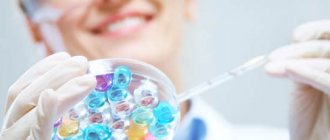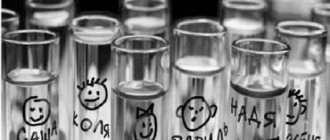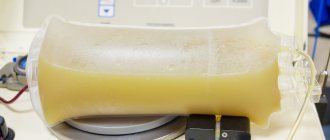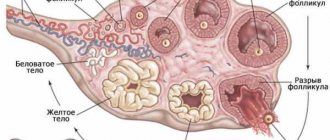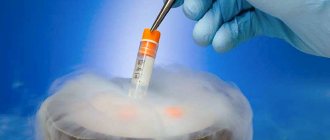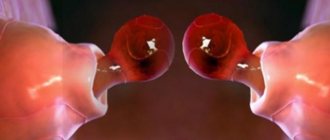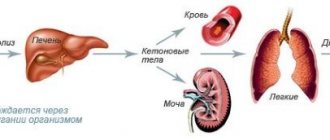Preparation for the procedure
Puncture of follicles requires mandatory preparation.
You should not have sex 3-5 days before the procedure. The day before, you need to have something light for lunch, and in the evening, skip dinner altogether and just drink tea. In the morning, before the procedure, the woman should neither eat nor drink. You should also not smoke or chew chewing gum. Since the procedure is performed, in most cases, in the first half of the day, you can be patient. As a rule, at the same time, if they are a married couple, the partner donates sperm.
You must also follow a special diet for a certain period of time. You cannot visit the bathhouse, sauna, or take a bath that is too hot. You need to drink enough water.
Cryo-freezing of eggs and embryos
Most modern clinics that take the problems of their patients seriously, helping them solve problems in overcoming infertility using the latest algorithms and advanced technologies existing in reproductive medicine, practice cryo-freezing of oocytes unused during IVF.
This is done to minimize the risk to a woman’s health when she repeatedly attempts to use artificial conception. For example, in case of failure or for the birth of new children, which the patient and her husband may plan in the future. After all, hormonal therapy, which is unsafe for health, as a mandatory stage of IVF in the preparation of several mature gametes with given qualities, in the future may be contraindicated for this woman or have a bad effect on her health, causing complications.
Having decided to return to the in vitro fertilization program, the spouses will not start it again from the very beginning if cryopreservation of the wife’s eggs took place in the past. A serious stage is automatically excluded from the program - stimulation of multiple ovulation, which will greatly facilitate the task and protect you from the aggressive hormonal effects of stimulating therapy.
Many leading clinics in large Russian cities have already created their own cryobanks. This requires equipping with the latest, expensive equipment (including for freezing gametes), used in the most famous clinics in the world related to reproductive medicine, as the most effective method of combating infertility.
The artificial conception program includes the main stage of a woman’s fertilization - implantation of 1 or 2 embryos into the uterus. As a result, spouses often end up with “extra” embryos.
If clients of the clinic wish, they can be preserved using freezing - cryopreservation. They will remain suitable for future use for many years to come
Cryopreservation of embryos is possible at any stage of their development. A reproductologist, together with an embryologist, selects a favorable time for freezing. Everything has its own individual characteristics.
Storage takes place in cryovials on which are written:
- woman's first, middle and last names,
- date of cryopreservation,
- number of embryos (or eggs).
Cryovials are placed in a special container containing liquid nitrogen. Biological materials are stored at a temperature
(-196 C).
The standard retention period is 10 years, the maximum possible is 55 years.
Cryopreservation of eggs and/or embryos gives hope to people suffering from malignant oncological diseases, after a successful outcome of treatment - surgical, chemotherapy, radiological - to have healthy biological children.
And, despite the aggressiveness of therapy methods in relation to the reproductive system, such patients who have undergone the procedure of cryopreservation of reproductive biomaterials retain the opportunity to be full-fledged parents.
How does the puncture occur?
A question that concerns many: how does the puncture of follicles from the ovaries occur during IVF, and what follows after? The woman is taken to a room where she changes clothes. Then she is sent to the operating room, where the puncture itself is performed.
The procedure is performed under general intravenous anesthesia. On average it takes 15-40 minutes, depending on the number of eggs.
Since before the puncture the woman takes special hormones, she is given injections to increase the number of mature eggs; there are many more of them than usual during a natural cycle.
After the procedure, the woman is sent back to the ward, where she needs to lie down for at least 2 hours to come to her senses and recover from the anesthesia. By this time, a doctor will approach her and tell her in detail how everything went and how many eggs were obtained.
How to explain the process of follicle puncture during IVF?
The puncture takes only 10-20 minutes. It is performed using a special hollow needle under the control of a vaginal ultrasound sensor using suction through the vagina. Along with the sensor, transvaginal ultrasound also enters the vagina to accurately monitor the process.
Since this is a painful procedure, it is done under local or general anesthesia. The doctor sees a line on the monitor that helps him determine the safest position for inserting the needle to collect the eggs. The operation lasts until the required amount of material is removed.
Before the procedure, an ultrasound will be required to see whether the size of the follicles corresponds to the norm - 17-20 mm, if so, then a sampling is performed. Including before the operation there should be at least three of them.
To increase the number of follicles, additional ovarian stimulation is performed before puncture. Prescribed hormones help create a sufficient number of functionally mature follicles.
Detailed procedure diagram - follicle puncture
Therefore, a woman who has decided to take such a step, before the puncture, 34-36 hours before, is given an injection that stimulates the release of luteinizing hormone - human chorionic gonadotropin or a gonadotropin-releasing hormone agonist.
The ovulation trigger accelerates the period of egg formation, and during this time the doctor tries to calculate as accurately as possible what day ovulation occurs, taking into account the accelerated process, due to drugs.
It is impossible to perform a puncture ahead of time, because the eggs will not reach full maturity. And the delay will lead to natural ovulation and the release of eggs into the abdominal cavity. Therefore, in the process itself, it is important not to miss the moment to take a puncture before the eggs leave the follicles and become unattainable for puncture.
On the same day, the patient's husband donates sperm. And after the woman’s eggs are extracted, they are transferred to embryologists. And they, in turn, perform fertilization with sperm. The resulting embryos are then placed in the uterus and the woman is examined for two weeks to determine whether the pregnancy has begun to develop or not.
If the embryo planted in the uterus does not take root, the woman stops taking hormones, and the suspended menstruation resumes again.
The menstrual cycle may last longer and be more abundant than usual. Before such a serious procedure, you need to conduct good hormonal preparation.
If your stomach hurts (and other pains)
In the afternoon, after the follicle function has been performed, the woman may have a stomach ache, a slight rise in temperature, tension in the abdominal area, and bloody vaginal discharge. There is nothing wrong with this, it is normal if the symptoms go away . You should definitely consult a doctor if several days have passed since the procedure, but the following signs are present:
- increase in abdominal size;
- high temperature for several days;
- after follicular puncture the stomach hurts for a long time;
- severe bleeding;
- stool disorders;
- pain when urinating, reminiscent of cystitis;
- nausea, vomiting, etc.
What is follicle puncture and why is it needed?
Before we talk about puncture during IVF, let's figure out what a follicle is and what role it plays in the female body. In simple terms, a follicle is a “house” for an egg, that is, the place where its birth and development occurs until the moment of ovulation. During the menstrual cycle, several follicles mature in a woman’s ovary, but only one of them, the dominant one, reaches the end and gives birth to an egg. The remaining follicles stop developing and die. There are situations in which several dominant follicles mature in the ovaries, in which case two eggs can be released and twins can be conceived.
The rupture of the dominant follicle and the release of an egg ready for fertilization is called ovulation.
Transvaginal follicular puncture is part of the IVF program, which is a surgical procedure to collect eggs from mature follicles using a needle. During the puncture, the ovarian wall is punctured and the follicular fluid containing the eggs is aspirated. Follicle puncture is performed until ovulation occurs and the egg is released into the fallopian tube. The best time for a puncture is on the eve of ovulation. After the eggs are collected in the laboratory, the fertilization process takes place.
Protein diet after the procedure
After the procedure, the woman is prescribed a drug that will support the second half of her cycle so that failure does not occur. Also, after follicular puncture, she is recommended to maintain a protein diet, which includes foods containing protein in her diet:
- lean meats
- egg white
- dairy products
- cereals, cereals, etc.
The main thing is that a woman, when trying to follow this diet, does not eat foods to which she may be allergic.
What is an ovarian wall puncture?
Ovarian puncture is a puncture of the ovarian wall in order to obtain the contents of the follicles. It is a surgical operation and is performed under anesthesia. The method is minimally invasive, since the area of injured tissue is not large. The operation itself lasts from 10 to 30 minutes. This is a mandatory stage of IVF.
The main task of a puncture during in vitro fertilization is the collection of viable eggs. After this, the egg is artificially fertilized, and then the fertilized egg is implanted into the uterine cavity.
Drinking alcohol after puncture
Since the procedure is performed under anesthesia, it is strictly forbidden to drink alcoholic beverages on this day. But, since the woman is preparing for IVF and in a few weeks the embryo will be implanted into her, it is better not to drink alcoholic beverages during this period, even if the doctor has allowed a little, because this can negatively affect the health of the woman and her unborn child. For IVF, Decapeptyl can be used both during the preparation process and after embryo transfer.
Complications after IVF
Any procedure that is performed without training or by an inexperienced specialist can have negative consequences. This also applies to IVF. Thus, stimulation of ovulation sometimes leads to hyperstimulation. As a result, ascites may develop, an accumulation of fluid in the abdominal cavity.
Complications sometimes arise after such a simple procedure as follicle puncture. Reviews from some patients are frightening - terrible pain, heavy bleeding. This is because during the puncture of the follicle, other pelvic organs may also be affected.
An equally common consequence of artificial insemination is infection. The main reason is medical negligence and unsterile conditions.
Therefore, you need to choose a clinic for IVF very carefully. And if such a manipulation as follicle puncture has negative reviews from patients, then the hospital that performs it should be avoided.
On what day of the cycle is it prescribed?
To achieve the best result, there is a certain point when it is necessary to perform an ovarian puncture. The egg must mature, but is still in the follicle. If ovulation occurs, the collection becomes impossible and is postponed to the next cycle .
Before the puncture, the fertility specialist prescribes a standard regimen for ovarian stimulation. According to this scheme, the puncture is carried out no later than 35-36 hours after the administration of hCG. It turns out approximately on days 12-22 of the cycle, 2 days before ovulation. The day of the operation is planned in advance, but ultrasound and hormonal monitoring is still carried out. The growth of follicles and the level of the hormone estradiol, which increases by the day of puncture, are monitored.
If the follicle has grown to 20 mm, but the egg has not matured, then the whole scheme begins again with the next menstrual cycle.
